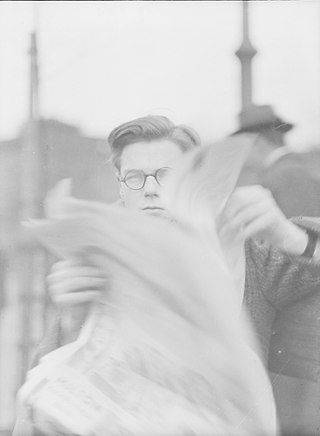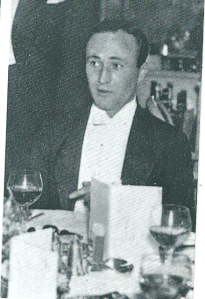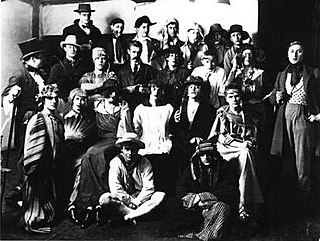
Major John Drury Boteler Packe-Drury-Lowe (16 October 1905 - 1 June 1960) was an English aristocrat, part of the Bright Young Things crowd of the 1920s.

Major John Drury Boteler Packe-Drury-Lowe (16 October 1905 - 1 June 1960) was an English aristocrat, part of the Bright Young Things crowd of the 1920s.
John Drury Boteler Drury-Lowe was born on 16 October 1905, the son of John Alfred Edwin Drury-Lowe, High Sheriff of Derbyshire, and Dorothy Drury-Lowe.
He attended Eton College and Oxford University. At Eton his contemporaries were Bryan Guinness, 2nd Baron Moyne, Harold Acton, Michael Parsons, 6th Earl of Rosse, Henry Yorke, Robert Byron, Brian Howard. [1] At Oxford Drury-Lowe was part of the Railway Club, which included: Henry Yorke, Roy Harrod, Henry Thynne, 6th Marquess of Bath, David Plunket Greene, Edward Henry Charles James Fox-Strangways, 7th Earl of Ilchester, Brian Howard, Michael Parsons, 6th Earl of Rosse, John Sutro, Hugh Lygon, Harold Acton, Bryan Guinness, 2nd Baron Moyne, Patrick Balfour, 3rd Baron Kinross, and Mark Ogilvie-Grant. [2]
He was one of the most popular students at Oxford and later became a distinguished military man. [2]
In 1930 John Drury Lowe married Rosemary Marguerite Hope-Vere, daughter of Lt-Col. James Charles Hope-Vere of Craigie Hall, and had one son Patrick John Boteler Drury-Lowe (1931–1993)
In 1936 he married Penelope Mary Packe, daughter of Edward Packe, and assumed as additional surname Packe. They had one son, Simon Jasper Packe-Drury-Lowe (born 1938). With the marriage, Prestwold Hall passed to the Drury-Lowe family and his son, Simon Jasper Packe-Drury-Low, inherited the house and estate in 1938.

Bryan Walter Guinness, 2nd Baron Moyne, was a British peer, poet, novelist and socialite. He was an heir to part of the Guinness family brewing fortune, and briefly married to Diana Mitford, one of the Mitford sisters.

Baron Moyne, of Bury St Edmunds in the County of Suffolk, is a title in the Peerage of the United Kingdom. It was created in 1932 for the Hon. Walter Guinness, a Conservative politician. A member of the prominent Guinness brewing family, he was the third son of the 1st Earl of Iveagh, who was himself the third son of Sir Benjamin Guinness, 1st Baronet, of Ashford.

Sir Harold Mario Mitchell Acton was a British writer, scholar, and aesthete who was a prominent member of the Bright Young Things. He wrote fiction, biography, history and autobiography. During his stay in China, he studied the Chinese language, traditional drama, and poetry, some of which he translated.
Jonathan Bryan Guinness, 3rd Baron Moyne, is a British peer, businessman and writer. A member of the Guinness family, he is the elder of the two sons of Bryan Guinness, 2nd Baron Moyne, and his first wife Diana Mitford. Until his retirement, he was a non-executive director of Guinness plc and a merchant banker with Messrs Leopold Joseph.

Brian Christian de Claiborne Howard was an English poet and later a writer for the New Statesman.

Sir Henry Roy Forbes Harrod was an English economist. He is best known for writing The Life of John Maynard Keynes (1951) and for the development of the Harrod–Domar model, which he and Evsey Domar developed independently. He is also known for his International Economics, a former standard textbook, the first edition of which contained some observations and ruminations that would foreshadow theories developed independently by later scholars.

Henry Frederick Thynne, 6th Marquess of Bath, styled Lord Henry Thynne until 1916 and Viscount Weymouth between 1916 and 1946, was a British aristocrat, landowner, and Conservative Party politician.

The Guinness family is an extensive Irish family known for its achievements in brewing, banking, politics, and religious ministry. The brewing branch is particularly well known among the general public for producing the dry stout Guinness Beer. The founder of the dynasty was Arthur Guinness. Beginning in the late 18th century, they became a prominent part of what is known in Ireland as the Protestant Ascendancy.

Laurence Michael Harvey Parsons, 6th Earl of Rosse, KBE was an Anglo-Irish peer.

William Edward Parsons, 5th Earl of Rosse was an Irish peer and British Army officer. He was known as Lord Oxmantown until 1908.
West Downs School, Romsey Road, Winchester, Hampshire, was an English independent preparatory school, which was established in 1897 and closed in 1988.

Prestwold Hall is a country house in Leicestershire, England, standing in 2,500 acres (10 km2) of land in the parish of Prestwold. It is both a private home and a venue for weddings and events.

John Sutro was a British film producer. He produced seven films between 1941 and 1951. He was a member of the jury at the 7th Berlin International Film Festival.
Sir Edward Hussey Packe KBE DL JP was a British civil servant.

Edward Henry Charles James "Harry" Fox-Strangways, 7th Earl of Ilchester was a British peer and philanthropist. He also held the subsidiary titles of Baron Strangways and Baron Ilchester and Stavordale.

Hon. Desmond Edward ParsonsFRAS was a British aristocrat, amateur sinologist, and aesthete, regarded as "one of the most magnetic men of his generation." He had a passionate friendship with James Lees-Milne, was the one true love of Harold Acton and the unrequited love of Robert Byron.

Charles Randolph Mark Ogilvie-Grant was a British diplomat and a botanist and one of the earliest members of the Bright Young Things. Despite his earliest frivolous past, he became a hero during the 1940–1941 Greek campaign.

The Hypocrites' Club was one of the student clubs at Oxford University in England. Its motto in Greek, from an Olympian Ode by Pindar, was Water is best. This led to the members being called Hypocrites, due to the fact that beer, wine and spirits were the chosen drinks.

William Hamilton Mitchell Acton was an Anglo-Italian painter.